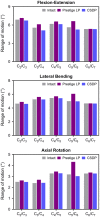Biomechanical Analysis of Cervical Artificial Disc Replacement Using Cervical Subtotal Discectomy Prosthesis
- PMID: 34336799
- PMCID: PMC8317600
- DOI: 10.3389/fbioe.2021.680769
Biomechanical Analysis of Cervical Artificial Disc Replacement Using Cervical Subtotal Discectomy Prosthesis
Abstract
Background: Anterior cervical discectomy and fusion (ACDF) sacrifices segmental mobility, which can lead to the acceleration of adjacent segment degeneration. The challenge has promoted cervical artificial disc replacement (CADR) as a substitute for ACDF. However, CADR has revealed a series of new issues that are not found in ACDF, such as hypermobility, subsidence, and wear phenomenon. This study designed a cervical subtotal discectomy prosthesis (CSDP) consisting of a cervical disc prosthesis structure (CDP structure), cervical vertebra fixation structure (CVF structure), link structure, and locking screw, aiming to facilitate motion control and reduce subsidence. The aim of this study was to assess the biomechanics of the CSDP using finite element (FE) analysis, friction-wear test, and non-human primates implantation study. Study Design: For the FE analysis, based on an intact FE C2-C7 spinal model, a CSDP was implanted at C5-C6 to establish the CSDP FE model and compare it with the Prestige LP prosthesis (Medtronic Sofamor Danek, Minneapolis, MN, United States). The range of motion (ROM), bone-implant interface stress, and facet joint force were calculated under flexion extension, lateral bending, and axial rotation. In addition, CSDP was elevated 1 mm to mimic an improper implantation technique to analyze the biomechanics of CSDP errors in the FE model. Moreover, the friction-wear test was conducted in vitro to research CSDP durability and observe surface wear morphology and total wear volume. Finally, the CSDP was implanted into non-human primates, and its properties were evaluated and verified by radiology. Results: In the FE analysis, the ROM of the CSDP FE model was close to that of the intact FE model in the operative and adjacent segments. In the operative segment, the CSDP error FE model increased ROM in flexion extension, lateral bending, and axial rotation. The maximum stress in the CSDP FE model was similar to that of the intact FE model and was located in the peripheral cortical bone region. The facet joint force changes were minimal in extension, lateral bending, and axial rotation loads in CSDP. In the friction-wear test, after the 150-W movement simulation, both the CVF-link-junction and the CDP-link-junction had slight wear. In the CSDP non-human primate implantation study, no subsidence, dislocation, or loosening was observed. Conclusion: In the FE analysis, the biomechanical parameters of the CSDP FE model were relatively close to those of the intact FE model when compared with the Prestige LP FE model. In terms of CSDP error FE models, we demonstrated that the implantation position influences CSDP performance, such as ROM, bone-implant interface stress, and facet joint force. In addition, we performed a friction-wear test on the CSDP to prove its durability. Finally, CSDP studies with non-human primates have shown that the CSDP is effective.
Keywords: biomechanics; cervical artificial disc replacement; facet joint; finite element analysis; prosthesis; range of segmental motion; stress.
Copyright © 2021 Wo, Lv, Wang, Shen, Zhu, Liu, Huang, Sun and Li.
Conflict of interest statement
The authors declare that the research was conducted in the absence of any commercial or financial relationships that could be construed as a potential conflict of interest.
Figures












Similar articles
-
Cervical subtotal discectomy prosthesis validated in non-human primate model: A novel artificial cervical disc replacement concept?Front Bioeng Biotechnol. 2022 Oct 13;10:997877. doi: 10.3389/fbioe.2022.997877. eCollection 2022. Front Bioeng Biotechnol. 2022. PMID: 36312530 Free PMC article.
-
Biomechanical evaluation of adjacent segment degeneration after one- or two-level anterior cervical discectomy and fusion versus cervical disc arthroplasty: A finite element analysis.Comput Methods Programs Biomed. 2020 Jun;189:105352. doi: 10.1016/j.cmpb.2020.105352. Epub 2020 Jan 21. Comput Methods Programs Biomed. 2020. PMID: 31991316
-
A new cervical artificial disc prosthesis based on physiological curvature of end plate: a finite element analysis.Spine J. 2016 Nov;16(11):1384-1391. doi: 10.1016/j.spinee.2016.06.019. Epub 2016 Jun 23. Spine J. 2016. PMID: 27345748
-
The Influence of Artificial Cervical Disc Prosthesis Height on the Cervical Biomechanics: A Finite Element Study.World Neurosurg. 2018 May;113:e490-e498. doi: 10.1016/j.wneu.2018.02.062. Epub 2018 Feb 17. World Neurosurg. 2018. PMID: 29462729
-
Adjacent segment biomechanical changes after one- or two-level anterior cervical discectomy and fusion using either a zero-profile device or cage plus plate: A finite element analysis.Comput Biol Med. 2020 May;120:103760. doi: 10.1016/j.compbiomed.2020.103760. Epub 2020 Apr 18. Comput Biol Med. 2020. PMID: 32421657
Cited by
-
Biomechanical evaluation of a novel individualized zero-profile cage for anterior cervical discectomy and fusion: a finite element analysis.Front Bioeng Biotechnol. 2023 Sep 7;11:1229210. doi: 10.3389/fbioe.2023.1229210. eCollection 2023. Front Bioeng Biotechnol. 2023. PMID: 37744254 Free PMC article.
-
Influence of the deviated center of rotation on facet joint degeneration after cervical disc replacement - an in vivo study with a minimum of 10-year follow-up.BMC Surg. 2024 Nov 4;24(1):344. doi: 10.1186/s12893-024-02615-9. BMC Surg. 2024. PMID: 39497120 Free PMC article.
-
Comparative Analysis of the Biomechanical Characteristics After Different Minimally Invasive Surgeries for Cervical Spondylopathy: A Finite Element Analysis.Front Bioeng Biotechnol. 2021 Dec 16;9:772853. doi: 10.3389/fbioe.2021.772853. eCollection 2021. Front Bioeng Biotechnol. 2021. PMID: 34976969 Free PMC article.
-
Human head-neck model and its application thresholds: a narrative review.Int J Surg. 2025 Jan 1;111(1):1042-1070. doi: 10.1097/JS9.0000000000001941. Int J Surg. 2025. PMID: 38990352 Free PMC article. Review.
-
Biomechanical Evaluation of Intervertebral Fusion Process After Anterior Cervical Discectomy and Fusion: A Finite Element Study.Front Bioeng Biotechnol. 2022 Mar 17;10:842382. doi: 10.3389/fbioe.2022.842382. eCollection 2022. Front Bioeng Biotechnol. 2022. PMID: 35372323 Free PMC article.
References
LinkOut - more resources
Full Text Sources

